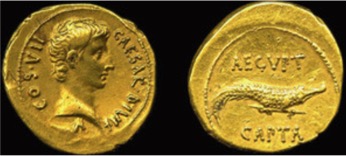All 2 entries tagged Crocodile
No other Warwick Blogs use the tag Crocodile on entries | View entries tagged Crocodile at Technorati | There are no images tagged Crocodile on this blog
December 01, 2019
The crocodile as a symbol of Egypt on a victory coin of Augustus
 |
Gold Aureus from 27BC (RIC 12, P.86, no. 544) The obverse depicts head of Augustus with ‘CAESAR.DIVI.F.COS.VII’ inscribed. On the reverse is a crocodile facing right, representing Egypt. The reverse legend reads ‘AEGVPT CAPTA.’ Image produced courtesy of the Trustees of the British Museum.
After a tense period of civil war, Octavian’s decisive victory at the Battle of Actium in 31BC left Marc Antony with insufficient military support to win the war, and a year later Egypt was conquered and absorbed into the Roman Empire. Marc Antony and Cleopatra committed suicide, leaving Octavian as the unrivalled, sole ruler of the Roman world, a victory he was keen to advertise. The above pictured coin is a gold aureus celebrating the acquisition of Egypt. It is typical of victory coinage, with the obverse depicting a portrait bust of the ruler (who was the victor), in this case Octavian, and the reverse depicting an image symbolic of the conquered nation, in this case a crocodile. The gold aureus is similar to a near identical issue of silver denarii struck in the previous year. Both coins hailed Octavian as son of the divine Julius Caesar, establishing his legitimacy on a political and religious level.
That Octavian chose the image of a crocodile to place on the reverse of his coins is of particular interest. First and foremost, it presents Octavian as the victor over a foreign enemy. Crocodiles were popular in Roman art as images representing foreign and exotic ideals, and their use here was no doubt intended to draw attention to the war in its international context, and thus overshadow the morally dubious truth of it being, in truth, a civil war. Octavian was now the sole ruler of Rome, having violently deposed of his co-consul. It was therefore crucial for him to deter any criticism and suggestions of tyranny. The crocodile was a particularly suitable image because of its associations with danger, and thus it had the added benefit of presenting Marc Antony as a threat to Rome. This helped to authorise Octavian’s war against his fellow Roman, and once-ally, and aligns with much of Octavian’s earlier propagandist campaign against him. The crocodile therefore helps to reinforce the idea that Octavian should be hailed, not as the violent murderer of his co-consul, but as the saviour of the Roman Empire.
 |
Coin of Crassus showing a crocodile. Image produced courtesy of the Classical Numismatic Group.
This is not the first time a crocodile had been used in Roman coinage. Already in 37BC, the crocodile had appeared on the coinage of a figure largely identified as M. Licinius Crassus, son of the triumvir Crassus. It is believed that this coin celebrated Roman territory ceded to Cleopatra VII of Egypt by Marc Antony. It is interesting therefore, that this same symbol of Egypt should be used by Augustus only ten years later to celebrate the exact opposite: the conquering of Egyptian territory by Rome. On the coin of Crassus, it is likely that the crocodile was chosen because of its associations with the Nile, which itself was associated with the agricultural wealth of Egypt. We can therefore infer that this earlier use of the image of the crocodile was intended to celebrate Egypt in a gesture of diplomacy. Octavian, aware of this, may well have deliberately used this same image, already known for its associations with agricultural wealth, in order to boast of his achievement at having acquired such an important nation into the Roman Empire. Rome relied heavily on Egypt for its imports of grain, and hence Octavian’s victory was of crucial importance. It is likely the coin instilled pride in its Roman viewers, for belonging to such a large, powerful empire.
As we have seen therefore, the coin presents Octavian as a successful military leader, who not only saved, but also contributed to the Roman Empire. It also served to justify his recent war against Marc Antony by presenting it as a foreign conquest. We can see that the imagery was carefully chosen in order to secure and validate Octavian’s position as sole ruler of Rome.
 |
This month's entry was written by Richa Snell. Richa is a final year classical civilization student with an interest in material culture and iconography, which she is hoping to pursue further by studying for a master’s degree next year. She is currently writing her undergraduate dissertation on imperial uses of Egyptian imagery.
Bibliography
R.A. Gurval (1995) Actium and Augustus: The Politics and Emotions of Civil War (Ann Arbor: University of Michigan Press).
C.E. Barrett (2017) ‘Egypt in Roman Visual and Material Culture’ in Oxford Handbooks Online in Classics Studies, ed. G. Williams (Oxford; New York: Oxford University Press).
M.Swetnam-Burland (2015) Egypt in Italy: Visions of Egypt in Roman Imperial Culture (Cambridge: Cambridge University Press).
D. Vagi, Crocodiles on Roman coins familiar as the emblem of Egypt – https://www.coinworld.com/news/precious-metals/crocodiles-on-roman-coins-familiar-as-the-emblem-of-egyptian-province.html (15 Feb 2015). Accessed 31 Oct 2019.
April 01, 2016
Crocodilian influences on the denarius of 28 BC
 |
| Denarius of Augustus from 28 BC. |
The first recorded time a crocodile appeared on a Roman coin was 37/36 BC, under the authority of M Licinius Crassus, an official who had authority over the Greek island Crete and the African region of Cyrenaica. Scholars have attempted to claim that this was the son of the triumvir Crassus who in 53 BC famously conducted the Parthian disaster. The historical content of the Crassus coinage is dubious and complicated but it would be fair to assume and accept scholarly debate that his crocodile represented renewed Egyptian authority over Cyrenaica, an honour that was ceded to the Ptolemaic ruler Cleopatra VII by the cunning Marc Antony.
However, when Augustus utilised the crocodile on his coinage it was as a focal point of celebration towards Rome’s acquisition of Egypt and revered his military triumph. The crocodile interestingly could serve as a sign of continued power and dynastical tenure or the polar opposite of capitulation. With the caption of ‘Aegypto capta’; ‘captured Egypt’ we are able to understand the multi-faceted potential of a crocodilian representation and how the crocodile signified power dependant on the way it was utilised .
To understand the sole purpose of the crocodile on the denarius of 28 BC would be enormously difficult. Commonly in Egyptian practice, crocodiles were to supposed to allude to, and be associated with, their relationship to the river god Nilus, from whom Egypt’s affluence and prosperity was supposedly derived. The crocodile was the epitome of Egyptian power and was typically indigenous to the Nile so it often acted like a glorified mascot. Augustus had left his use of the crocodile imagery purposefully open to interpretation so that it could represent the formidable animal in which the Romans were so curious about, and were so proud to have enslaved, because it embodied the fate of Egypt. Or did it signify and celebrate the prosperity of Egypt through the crocodile’s relation to Nilus?
The best insight into the truth is the coinage of the colony of Nemausus (Nîmes) struck under Augustus: here a crocodile is depicted chained to a palm tree and is undeniably the sign of Egypt subdued to the power of Rome and presumably is a continuation of attitude from the denarius of 28 BC. The obverse of the denarius of 28 BC, a bareheaded and heroically unadorned bust of Augustus, has a protuberant brow alongside a wry smile which is meant to reaffirm the legitimacy of his autocratic reign by reasserting his military success, ultimately bringing us back to the subject of power. The crocodilian imagery on these coins was a boast of power, eastern luxury, but more importantly, it was who wielded and subjugated the crocodile that decided who the ancient beast would transfer its power to.
 This month's coin was written by Alfred Wrigley. Alfie is a second year ancient history and classical archealogy student who is hoping to specialise in and write his dissertation on Julio Claudian coinage.
This month's coin was written by Alfred Wrigley. Alfie is a second year ancient history and classical archealogy student who is hoping to specialise in and write his dissertation on Julio Claudian coinage.
Coin image reproducted courtesy of the Trustees of the British Museum.
 Clare Rowan
Clare Rowan

 Please wait - comments are loading
Please wait - comments are loading

 Loading…
Loading…

